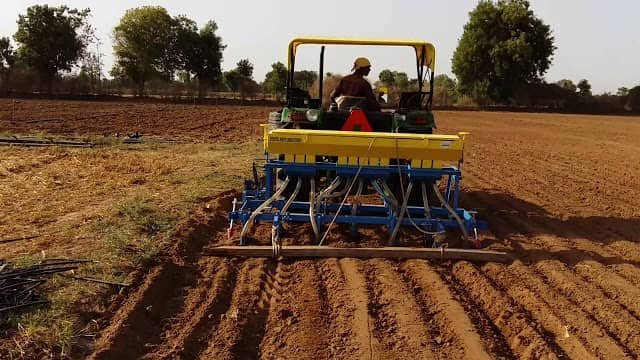Drilling Method of Sowing Seeds with advantage, disadvantage, and field Conditions: Drilling is the practice of dropping seeds in rows and furrows. Rows and furrows of predetermined dimensions are made seeds are dropped at a definite depth and distance, covered with soil, and compacted. Sowing implements such as the seed drill or seed-cum-fertilizer drill are used. After seeding the field may be leveled or ridged. During seeding, other operations such as the drilling of manures and fertilizers, pesticides, and soil amendments are also done simultaneously.
Seed drilling is a planting method that uses a seed drill to place seeds in the ground. The seed drill opens furrows in the soil and then deposits the seeds into the furrow. The seed drill also covers the seeds with soil to protect them from wind and animals.

There are two main drilling methods of sowing seeds: push and pull drills. The push drill is operated by pushing the seed tube into the soil and then pulling it back out, while the pull drill is operated by pulling the seed tube through the soil. The choice of a push or pull drill depends on the type of soil and the amount of power available. In general, the push drill is better for harder soils, while the pull drill is better for softer soils.
Drilling Method of Sowing Seeds
During drilling, seeds may be sown continuously or at regular intervals in the rows. These rows may be straight and parallel or staggered and irregular. Rows may be arranged as paired row planting, or bi-directional (cross row planting). Drilling may be adopted for both pure cropping and intercropping situations. Seeds are planted in groups of two to three at a uniform distance between them.
Planting in rows
Planting in rows may be of the following types-
- Continuous seeds in the row at irregular distance between seeds. This is a more common method for planting small grains. Seed depth is more uniform with this type of planting.
- Seeds spaced at uniform distance. Precision planting, with uniform distance between or group of plants in a row, is used for crops like corn, beans, peas, soybeans and garbanzo. These crops are sensitive to spacing and they require uniform distances between plants.
- Seeds planted at same distance from row to row and seed to seed. This type of planting is used when it is necessary to cultivate the crop down the row and across.
- Continuous seeds planted in double row. Sometimes, to make harvesting easier and to better utilize the land, peas and soybeans are planted in double row.
Planting in furrows
Planting in furrows may be of the following types-
Seeds planted in the furrow at a uniform distance between them. In semiarid areas or during the dry season, corn and beans are planted in the furrow to take advantage of the available moisture.
Seeds planted on top of the furrow at a uniform distance between them. In areas with frequent rainfall, maize and beans are planted on top of the furrow to avoid waterlogging the seeds.
Advantages of Drilling Method
Drilling maintains a uniform plant population per unit area per running meter in the rows. In addition, the rows are set according to the requirements. Seeds are placed at a uniform depth and covered and compacted uniformly in this method. Uniform plant population per unit area facilitates the prediction of expected yield. Other advantages are:
- The seed rate becomes less.
- Drilling facilitates thinning and roughing of weak and diseased plants.
- Weeding can be done profitably within a short time by wheel hoe, Japanese rice weeder etc.
- The intercultural operations such as earthing up, manuring, irrigation, spraying etc. can be done successfully in the drilled crops.
- The drilled crops get light, air, nutrients equally as they are spaced at uniform distance.
- Harvesting of crops is easier and advantageous. So, harvesting cost becomes less.
- Drilling may be adopted for both sole cropping and intercropping situations.
- The cost of cultivation in drilled crop becomes less and the yield of drilled crop increases.
Disadvantages of Drilling Method
- Drilling requires an implement such as a seed-drill which increases the cost of cultivation. ii.
- Drilling requires more time, energy and cost.
- An expert technical person is required for running of a seed-drill.
- Drilling needs more time in comparison to broadcasting.
- Drilling is not feasible in clay and stony soils.
Field condition for drilling method
Seeds are sown in dry or semi-dry soil conditions. Crops such as wheat, mustard, upland rice, barley, black gram, green gram, bengal gram, berseem, lucerne, jute, safflower, sesame, niger, cumin, and coriander are sown by drilling.
In conclusion, seed drilling is an effective way to plant seeds that leads to successful crops. It is a reliable and efficient method that farmers can use to improve their yields. With the help of seed drills, they can achieve a more consistent planting depth, which leads to improved germination and emergence. By using this technology, farmers can increase their production and make more money.
